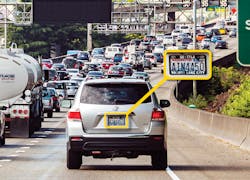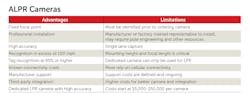Tech Deep Dive: Automated License Plate Recognition
Automated License Plate Recognition (ALPR) or Automated Number Plate Recognition (ANPR) refers to security cameras that have been around since the early 1980s to identify vehicles by license plate. ALPR is used primarily in North America, while ANPR is found in Europe and European influenced countries.
The first commercial LPR cameras were large analog box cameras mounted at tag level with a special filter to capture the raised tag numbers. Today, ALPR cameras are much smaller, with optimal mounting height of 12 feet on a pole, consisting of one or two cameras with infrared illuminators (IR) – both internal and/or external – to help build tag definition.
While ALPR cameras have typically been deployed in both fixed and mobile applications by public safety organizations, ALPR cameras are now becoming much more common in commercial and B2B applications.
With the introduction of the Internet of Things (IoT) and IT/IoT/ OT convergence, ALPR camera is being developed and sold to meet new and unique customer needs. As the ALPR technology grows, gains accuracy, and prices drop, more businesses and neighborhoods will begin to use this technology as a means to offer access control, revenue generation, and overall safety.
Product Choice: LPC or LPR?
Today there are two primary types of ALPR cameras – License Plate Capture (LPC) and License Plate Recognition (LPR). LPC cameras require enough megapixels to be able to zoom to get an accurate “read” of the plate. All LPCs are IP cameras designed to run Optical Character Recognition (OCR) analytic. The LPC is limited as it requires a manual input of license tags, and a manual review for a match.
LPR cameras or analytics are designed for “recognition” and automation/integration of the recognition software to provide immediate “hits” via a traditional video management system (VMS) or a connection to cloud shared or government repositories.
The confusing area here is that some LPR cameras can be IP cameras running OCR analytics. The robustness of the analytic becomes a deciding factor, as both offer distinct value depending on the use-case. For either option, depending on type and installation, costs can span a wide range – from $2000 to $50,000 or more for a single camera installation.
Decisions for integration into third-party platforms such as parking software, B2B connections, or public safety should be identified during the design phase, as this can determine which type of camera is specified.
LPC Benefits and Drawbacks
A traditional IP camera with OCR analytics is a color sensor camera surrounded by a ring of infrared (IR) illuminators of one wavelength, typically around 850nm. For the purposes of ALPR, the camera manufacturer typically includes a way to upload a whitelist (approved) or blacklist (alert) on the camera. Whitelist tags can be used for access control, while blacklist tags create an alarm either local to the camera or on a VMS or recording platform to alert the user.
One advantage of the IP camera is that it can be used as another security camera and not be limited to a single function.
Many camera manufacturers now offer an LPC camera for OCR analytics, but the analytics do not come installed. A separate analytic package must be purchased. Some IP cameras have the ability to run the analytic on the camera; others require an edge device to be co-located with the device or run on an analytics server at the head end. These additional hardware and software applications will affect the installation cost.
Analytics packages can integrate with Point of Sale systems for pay to park scenarios. Depending on the manufacturer or integrator, the LPC can be purchased upfront or as a subscription plan.
Ideal use-cases for IP cameras with OCR include: Pay to park, with the camera in a fixed location with good ambient light; neighborhood entrances with good lighting; vehicle recognition for member loyalty programs; and access control for residential parking decks.ALPR Benefits and Drawbacks
The traditional ALPR camera comes in a housing with one or two camera sensors. If one sensor, the sensor will be a black-and-white camera with a fixed focal length, which is determined prior to ordering and will be set and calibrated prior to shipping.
If the unit has two sensors, the second camera will be a small color camera for context views while aiming the black-and-white camera. The camera may be an IP camera, but it may have proprietary cabling to a co-located power supply or network device.
These devices typically have multiple wavelengths of IR illuminators, ranging from 710nm to 950nm for ranged recognition of tags.
Like the IP camera, these cameras have multiple whitelist and blacklist databases onboard. The cameras may have a version of Windows or Linux embedded on the camera itself. The ALPR camera has a way to record tag matches onboard if disconnected, and once connected, it uploads all tag data to a recording platform – which may be a pay-to-park software, a VMS (either on-premise or cloud hosted), shared repository or government repository.
A shared repository would be a cloud-hosted option that enables multiple vendors to match recognitions to other vendors. This works well for applications where tow truck drivers get “hits” from other ALPR camera locations. Two government repositories are the National Crime Information Center (NCIC) hotlist and the Drug Enforcement Agency’s High Intensity Drug Trafficking Area (HIDTA) hotlist. These hotlists are accessible only to public safety, and each department must apply for access to be provided a time of day when their server will access the list.
Most LPR cameras are set up from the factory to use a cellular connection. Each LPR camera location will be set up as a stand-alone location transmitting back to a central repository. Each additional camera at the site will be added to the location; each new location will be a separate stand-alone application with new hardware and hardware costs.
Ideal use-cases for LPR cameras include: B2B offerings, such as for towing companies; city and campus parking solutions; public safety applications; locations where higher speeds are being used; toll roads; and public/private partnership (P3s) to include businesses and neighborhoods.Mobile ALPR Cameras
Unlike LPC cameras, most LPR camera manufacturers have created a version of the LPR camera that can be mounted on a vehicle. These mobile cameras may still have proprietary cabling, but they will have a power supply mounted inside the vehicle.
Like the fixed LPR camera, the mobile version is ready to use a cellular connection, either dedicated or as part of the vehicle infrastructure. Mobile LPRs can be found on public safety vehicles, tow trucks, parking services vehicles, trailer drawn applications and in covert applications.
Installation Best Practices
Fixed Installations: For accurate tag recognition, the ALPR camera should be mounted at 12 feet, with a focal point based on the camera lens or camera zoom ability. The camera should be mounted to focus on one lane at a time.
While many offer a focal length and lens aperture to capture multiple lanes, the computing power in the camera needed to “see” multiple cars and even to send the images is more than most cameras. If the camera is running an onboard analytic, this computing power will be battered even more. The camera should have the ability to capture tags at 30 mph faster than the expected vehicle speed.
Mobile Applications: Mobile applications have many variables, but should have good connectivity and compute internally to process images quickly and accurately. Mobile applications can use magnetic mounts for temporary applications or can be bolted to a vehicle for permanent installations. Ensure all penetrations are sealed appropriately. Most mobile applications will be performed by the manufacturer or factory trained representative.
Jon Polly is the Chief Solutions Officer for ProTecht Solutions Partners (www.protechtsolutionspartners.com), a security consulting company focused on smart city surveillance. Connect with him on linkedin: www.linkedin.com/in/jonpolly.
About the Author

Jon Polly
Jon Polly is the Chief Solutions Officer for ProTecht Solutions Partners (www.protechtsolutionspartners.com), , a security technology consulting firm that works with smart cities and corporations to bring business intelligence and public safety through security IoT applications. He has worked as a Project Manager and System Designer for City-Wide surveillance and Transportation camera projects in Raleigh and Charlotte, N.C.; Charleston, S.C.; and Washington, D.C. He is certified in Critical Chain Project Management (IC3PM) by the International Supply Chain Education Alliance (ISCEA). • (704) 759-6837


